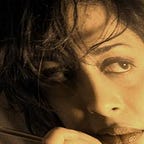Waking Up the Dead: The Big Sleep (1946)
The beloved noir mystery is Bogart and Bacall’s best pairing
A celebrated noir movie, The Big Sleep is also has one of the most convoluted plots in Hollywood history. Legend has it that director Howard Hawks actually had to call Raymond Chandler to find out who the murderer was. The Big Sleep is nonetheless one of the few films that is confusing yet constantly entertaining, not the least because of the real-life romance between its stars, Humphrey Bogart and Lauren Bacall. The film has that rare achievement of seducing the audience on style alone — even if some murders are left unsolved.
The Story
Los Angeles private detective Philip Marlowe is hiring by ailing millionaire General Sternwood to investigate some gambling debts incurred by his youngest daughter Carmen. His other daughter Vivian is worried that Marlowe has been hired to find her missing husband Regan, and they instantly clash. Marlowe’s investigation leads him to pornographers, racketeers and dead bodies; moreover, he can’t seem to shake free of either of the Sternwood women.
The Adaptation
Raymond Chandler published his first novel The Big Sleep in 1939, and it is considered one of the finest examples of noir fiction then or now. Chandler set all his novels in Los Angeles, most featuring the tough but noble private detective Philip Marlowe, the archetype for every hardboiled, soft-hearted private detective that came later. Chandler’s stories take place in the seedy underbelly underneath California’s golden exterior; his characters are usually decadent, desperate or both, and anyone good needs Marlowe’s help to survive. The Big Sleep has a meandering plot that leads Marlowe from one suspect to another until you lose track of who got murdered and why; but such is Chandler’s hypnotic style that you enjoy the journey anyway.
When Howard Hawks began filming The Big Sleep in 1946, none of Chandlers novels were still in print. The movie’s casting of Bogart and his real-life wife Lauren Bacall meant that romance becomes the center of the film, and other characters’ roles were reduced to capitalize on their chemistry. Hawks is less interested in the Los Angeles mean streets and more interested in how Marlowe’s interactions reveal more about who he is. Hawks and Chandler shared a cynical view of law society, but the movie ends on a happy note because of the romance between Vivian and Marlowe. The film comes alive when they trade wisecracks, insults and double-entendres, making it one of the sexiest classic films of all time
Apart from changing Vivian’s character from a femme fatale into real love interest, there are other significant changes to the film. The production required that numerous scenes be re-shot and deleted entirely; as a result, the solution to the murder mystery is even more incomprehensible than the book and at least one murder is left unsolved. The Production Code also required that references to the pornography or homosexual relationships be muted, the film portrays a sanitized version of the depravity that ensnared the Sternwood girls. Another difference is that much of Chandler’s criticism of the police is toned down; while they interrogate Marlowe in the movie, they seem far less antagonistic than they do in the book and the themes of police corruption are never examined.
There are few movies as enjoyable as The Big Sleep, even if it does devolve into unrealistic plots and hold out on the solution towards the end. Hawks is a confident enough director to be able to capture the moral complexities found in Chandler’s writing even when he couldn’t extricate a coherent narrative from Chandler’s complicated story. Unlike many noirs and despite its darker elements, The Big Sleep is delightful, an adaptation that made Philip Marlowe — and Humphrey Bogart— the last word on the noir private eye.
